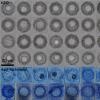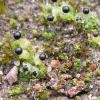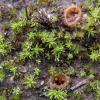
19-02-2015 14:16
 Miguel ├üngel Ribes
Miguel Ángel Ribes
I have this semiglobose-turbinate Lamprospora, in

19-02-2015 10:11
Peter WilberforceHello Everyone, I would appreciate some help with

18-02-2015 01:18
 Miguel ├üngel Ribes
Miguel Ángel Ribes
Hello, good nightI have a great doubt. When the pa

06-02-2015 00:08
 Miguel ├üngel Ribes
Miguel Ángel Ribes
Good night friendsOn Fagus sylvatica too we found

18-02-2015 12:05
Hi to everybody These small (0.3-0.4 mm) orange p

17-02-2015 11:50
Chris JohnsonGood morningThis was found a few days ago on pony
Lamprospora maireana 261214 01
Miguel Ángel Ribes,
19-02-2015 14:16
 I have this semiglobose-turbinate Lamprospora, in a nude soil with some mosses, in an area without vegetation inside a chestnut forest (Castanea) in La Gomera island (Canary Islands). I think it has a very characteristic spores, but I have never seen it before.
I have this semiglobose-turbinate Lamprospora, in a nude soil with some mosses, in an area without vegetation inside a chestnut forest (Castanea) in La Gomera island (Canary Islands). I think it has a very characteristic spores, but I have never seen it before.Asci octosporic, with croziers, (291.7) 303.1 - 366.7 (380.5) x (22.7) 23.3 - 30.5 (31.8) ┬Ąm;┬ĀN = 14; Me = 328.0 x 27.7 ┬Ąm.
Spores globose with a big guttule and ornamented with big warts, shaped like a flower petals,┬Ā(20.9) 21.6 - 23.7 (24.6) x (20.8) 21.2 - 23.2 (24.5) ┬Ąm;┬ĀQ = 1.0 (1.1); N = 84;┬ĀMe = 22.6 x 22.1 ┬Ąm ; Qe = 1.0
Is it necessary some more data to confirm it?
Thank you.
Miguel Á. Ribes.
Jan Eckstein,
19-02-2015 15:04
Re : Lamprospora maireana 261214 01
Dear Miguel,
indeed, it is Lamprospora maireana. The large tubercles with internal cavities are unique. Interestingly, this species is associated with the moss Archidium alternifolium in central and northern Europe. In southern Europe it is mostly found near the hepatic Fossombronia whereas the parasitic relationship to Fossombronia could not be established so far. There is no Archidium on your first image but in the upper middle could be a Fossombronia.
with best wishes
Jan
indeed, it is Lamprospora maireana. The large tubercles with internal cavities are unique. Interestingly, this species is associated with the moss Archidium alternifolium in central and northern Europe. In southern Europe it is mostly found near the hepatic Fossombronia whereas the parasitic relationship to Fossombronia could not be established so far. There is no Archidium on your first image but in the upper middle could be a Fossombronia.
with best wishes
Jan
Miguel Ángel Ribes,
19-02-2015 15:45
Javier Ormad,
19-02-2015 16:58
Miguel Ángel Ribes,
19-02-2015 17:17

Re : Lamprospora maireana 261214 01
Gracias Javier
┬┐Cu├Īl es la Fossombronia, las que parece una lechuga con las bolitas negras o la otra?
┬┐Cu├Īl es la Fossombronia, las que parece una lechuga con las bolitas negras o la otra?
Gilbert MOYNE,
19-02-2015 17:26
Re : Lamprospora maireana 261214 01
Jamais eu la chance de la rencontrer sur le terrain...
Les spores sont tr├©s typiques
Gilbert
Les spores sont tr├©s typiques
Gilbert
Javier Ormad,
19-02-2015 17:39
Re : Lamprospora maireana 261214 01
Si.
Ya comentamos entonces (hace 7 a├▒os) esa posibilidad de asociaci├│n.
Ya comentamos entonces (hace 7 a├▒os) esa posibilidad de asociaci├│n.
Marcel Vega,
19-02-2015 18:26
Re : Lamprospora maireana 261214 01
Hola Javi,
donde la has recogido?
En Portugal crece frecuentemente con Fossombronia caespitiformis (pero tambi├®n con A. alternifolium). Como Jan ha escribido ya era imposible de encontrar la infecci├│n del musgo Fossombronia aunque tenemos varias colecci├│nes...
Saludos,
Marcel
donde la has recogido?
En Portugal crece frecuentemente con Fossombronia caespitiformis (pero tambi├®n con A. alternifolium). Como Jan ha escribido ya era imposible de encontrar la infecci├│n del musgo Fossombronia aunque tenemos varias colecci├│nes...
Saludos,
Marcel
Javier Ormad,
19-02-2015 18:47
Re : Lamprospora maireana 261214 01
Tenemos dos zonas de recolecci├│n en la provincia de Valencia, una en la zona de Enguera y otra en La Ca├▒ada, Paterna.
Saludos
Saludos
Miguel Ángel Ribes,
19-02-2015 22:25

Re : Lamprospora maireana 261214 01
I have no idea about mosses, but I think in my second macro picture, down right, there is a Fossombronia; but the other it is not Archicium.
Only Lamprospora dicranellae is cited in Canary Islands.┬Ā
Thaks to all.
Only Lamprospora dicranellae is cited in Canary Islands.┬Ā
Thaks to all.






